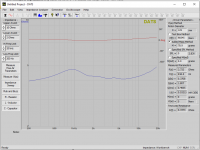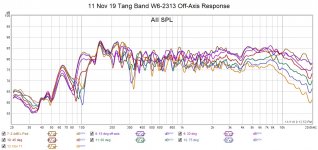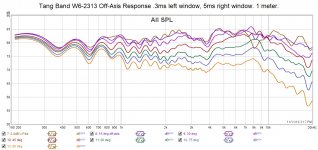Thanks, Scott and Murat.
After Scott's comment, I'll probably stick with a sealed box...er, enclosure. I don't need another large speaker in my house. Actually, I don't need another speaker in my house, but this does keep me off the streets.
I'll mate it with a sub.
After Scott's comment, I'll probably stick with a sealed box...er, enclosure. I don't need another large speaker in my house. Actually, I don't need another speaker in my house, but this does keep me off the streets.
I'll mate it with a sub.
I just got two of these today. One had a tapping/ticking noise during the 15Hz high-excursion break-in. It wasn't the voice coil leads hitting the cone, so an exchange is on the way.
I'm posting my results from DATS. Notice the Levc of .66mH, not the .02 from the data sheet.
I'm posting my results from DATS. Notice the Levc of .66mH, not the .02 from the data sheet.
Attachments
I got the enclosure built, the speaker installed, and the crossover modeled and road-tested. So far I have only a couple of hours burning in the speaker, but it does sound really good. I'll capture some of the REW charts tomorrow.
It sounds hot without any padding on the tweeter. I'll bring it down 3dB tomorrow and give a listen, knowing that it'll take a while to break in. I'll also feel better about the 1st order, 2kH crossover with a little padding. I don't plan on listening at high volumes, but still, sometimes the Coronas kick in.
I learned how to take near field and far field measurements and turn them into FRDs. I used those, along with the ZMAs from DATS to model the crossover in Xsim. I was surprised how close the speaker measured to the sim. I only took a 1 meter far field, but I'll add some more later.
The first thing I noticed about this driver was the dispersion. I haven't taken any off-axis measurements yet, but just walking around while it was playing Steely Dan was very impressive. I'd like to think it's due the hours of sanding the baffle into a KEF look-alike. USA1.com has the best sandpaper.
I should be getting the replacement for the bad driver from PE this week. No problems with the return. I even let the Tech Support guy listen to the noise it was making while I was waiting on the RMA.
I also added an REW chart showing what happens when you don't put any absorption panels or Acoustistuff in the enclosure.
edit: Found the REW sweep from the finished product.
More to follow.
Rick
It sounds hot without any padding on the tweeter. I'll bring it down 3dB tomorrow and give a listen, knowing that it'll take a while to break in. I'll also feel better about the 1st order, 2kH crossover with a little padding. I don't plan on listening at high volumes, but still, sometimes the Coronas kick in.
I learned how to take near field and far field measurements and turn them into FRDs. I used those, along with the ZMAs from DATS to model the crossover in Xsim. I was surprised how close the speaker measured to the sim. I only took a 1 meter far field, but I'll add some more later.
The first thing I noticed about this driver was the dispersion. I haven't taken any off-axis measurements yet, but just walking around while it was playing Steely Dan was very impressive. I'd like to think it's due the hours of sanding the baffle into a KEF look-alike. USA1.com has the best sandpaper.
I should be getting the replacement for the bad driver from PE this week. No problems with the return. I even let the Tech Support guy listen to the noise it was making while I was waiting on the RMA.
I also added an REW chart showing what happens when you don't put any absorption panels or Acoustistuff in the enclosure.
edit: Found the REW sweep from the finished product.
More to follow.
Rick
Attachments
-
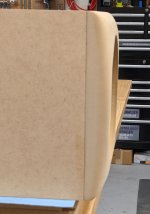 IMG_20191110_213544.jpg171 KB · Views: 446
IMG_20191110_213544.jpg171 KB · Views: 446 -
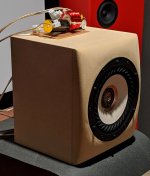 IMG_20191110_211625.jpg176.2 KB · Views: 485
IMG_20191110_211625.jpg176.2 KB · Views: 485 -
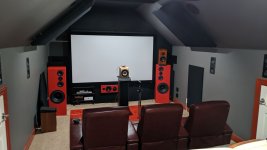 IMG_20191110_211518.jpg119.7 KB · Views: 384
IMG_20191110_211518.jpg119.7 KB · Views: 384 -
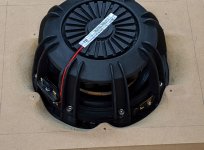 IMG_20191108_080450.jpg241.5 KB · Views: 345
IMG_20191108_080450.jpg241.5 KB · Views: 345 -
 IMG_20191108_080403.jpg221.3 KB · Views: 378
IMG_20191108_080403.jpg221.3 KB · Views: 378 -
 Tang Band W6-2313 Nearfield Woofer With and Without Absorbent Panels and Acoustistuff.jpg96.2 KB · Views: 615
Tang Band W6-2313 Nearfield Woofer With and Without Absorbent Panels and Acoustistuff.jpg96.2 KB · Views: 615 -
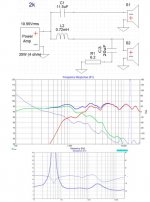 TB W6_2313 2k xover 1st Order.JPG53.7 KB · Views: 618
TB W6_2313 2k xover 1st Order.JPG53.7 KB · Views: 618 -
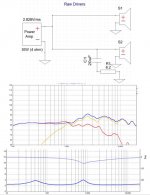 TB W6_2313 Raw Drivers.JPG54 KB · Views: 622
TB W6_2313 Raw Drivers.JPG54 KB · Views: 622 -
 TB W6_2313 First Measurement 10 Nov 19.jpg87.2 KB · Views: 372
TB W6_2313 First Measurement 10 Nov 19.jpg87.2 KB · Views: 372
Last edited:
Be careful with that 1st order, 2kHz crossover. Sounds way too low...
How on the earth did you make those front baffles? Sand paper should not be enough. Fantastic job!!
How on the earth did you make those front baffles? Sand paper should not be enough. Fantastic job!!
Fantastic cabinet work, but a 1. order is a hopeless idea. Even with a RCL circuit to eliminate the impedance rise at the tweeters Fs.
GoldStar Sandpaper Sheets
This is the sandpaper I used. Really good cutting, and it doesn't clog up. I started out using a belt sander to get the basic shape, then finished up with a sanding block and the Goldstar paper. It took less time than I thought it would. And, yes, I have a pretty good dust collection system in my shop. MDF particles are not good.
You're right about the 1st order. I'm hoping that padding it down will protect the tweeter.
This is the sandpaper I used. Really good cutting, and it doesn't clog up. I started out using a belt sander to get the basic shape, then finished up with a sanding block and the Goldstar paper. It took less time than I thought it would. And, yes, I have a pretty good dust collection system in my shop. MDF particles are not good.
You're right about the 1st order. I'm hoping that padding it down will protect the tweeter.
Here's the MDAT file from REW covering the near and far field measurements.
edit: Apparently not. Hey, Moderator, how come I can't post REW MDAT files?
Rick
edit: Apparently not. Hey, Moderator, how come I can't post REW MDAT files?
Rick
Last edited:
You're right about the 1st order. I'm hoping that padding it down will protect the tweeter.
I am afraid padding down is not an effective way of protecting that tweeter. You wouldn't like to loose much of the highs anyway. At least, please keep the volume limited while experimenting with such a huge capacitor in front of the tweeter.
One should not be seduced by a nice measurement of frequency response. Distortion and power handling are compromised severely by a 1. order at 2 KHz. Out of close to 100 tweeters this size in 40 years that have crossed my ears and test bench, I cant really think of one that performs well with a filter like that.
Here's the MDAT file from REW covering the near and far field measurements.
edit: Apparently not. Hey, Moderator, how come I can't post REW MDAT files?
Rick
The .mdat extension isn't one of the allowed file types to upload. When you click on "Manage Attachments" scroll to the bottom of the window to see the allowed extensions. Your best bet is to zip the file before uploading.
Zip the file. That makes sense. I'll do that.
I saw the list of allowed files, but figured I'd give it a try.
I'm attaching a screenshot of REW with the 2.4 dB L-Pad, and off-axis response measurements. I forgot to label measurement #13, but it's at 90 deg off-axis.
I saw the list of allowed files, but figured I'd give it a try.
I'm attaching a screenshot of REW with the 2.4 dB L-Pad, and off-axis response measurements. I forgot to label measurement #13, but it's at 90 deg off-axis.
Attachments
Last edited:
Looks like there is very long IR gating used, off-axis past 40deg should be much lower! 4 or 5 ms gating can show response well down to roughly 800Hz.
Tweeeter level is 5-6dB hot! Your 75deg response looks like normal on-axis goal!
What was measuring distance? Looks like you rotated the speaker, good!
Waiting for raw measurements!
Tweeeter level is 5-6dB hot! Your 75deg response looks like normal on-axis goal!
What was measuring distance? Looks like you rotated the speaker, good!
Waiting for raw measurements!
Thanks for the input, Juhazi.
Should I use the same gating as when I did for the far field measurements? I think it worked out to 300us on the left window and 4.6ms on the right window. I used the impulse response to determine the gating, but I never did see much in the way of first-reflection peaks. My room is fairly well treated, though, as you can see in the above pictures.
I'm still working on the crossover. I may bring the tweeter down some more, but I'll wait a little longer for the speaker to break in.
Measuring distance was 1 meter, and I didn't rotate the speaker, I moved the mic. Is that a better technique?
In case you haven't figured it out, I'm really new at speaker designing. I've built several designs from other people, but never my own.
Rick
Should I use the same gating as when I did for the far field measurements? I think it worked out to 300us on the left window and 4.6ms on the right window. I used the impulse response to determine the gating, but I never did see much in the way of first-reflection peaks. My room is fairly well treated, though, as you can see in the above pictures.
I'm still working on the crossover. I may bring the tweeter down some more, but I'll wait a little longer for the speaker to break in.
Measuring distance was 1 meter, and I didn't rotate the speaker, I moved the mic. Is that a better technique?
In case you haven't figured it out, I'm really new at speaker designing. I've built several designs from other people, but never my own.
Rick
Last edited:
Rotating the mic is worse, all reflections from boundaries will change! for quick sanity check measurements turmning the mic might be ok, I do that too, handheld!
IR right window gating is what counts for!
You can easily make a turntable from two sheets of board and a single nail or screw. The upper plate can be round at least for 180deg with markings for angles. Put this turntable on a kitchen ladder or a small table, then speaker on it so that speaker's baffle crosses the turning axis. Manual operation!

IR right window gating is what counts for!
You can easily make a turntable from two sheets of board and a single nail or screw. The upper plate can be round at least for 180deg with markings for angles. Put this turntable on a kitchen ladder or a small table, then speaker on it so that speaker's baffle crosses the turning axis. Manual operation!

Last edited:
One had a tapping/ticking noise during the 15Hz high-excursion break-in.
Slapping the back plate maybe?
Slapping the back plate maybe?
No, it wasn't that high-excursion. Just to make sure, I turned down the volume and it still made the noise. It sounded more like a voice coil lead tapping the cone, but it wasn't that, either.
Rotating the mic is worse, all reflections from boundaries will change! for quick sanity check measurements turmning the mic might be ok, I do that too, handheld!
IR right window gating is what counts for!
You can easily make a turntable from two sheets of board and a single nail or screw. The upper plate can be round at least for 180deg with markings for angles. Put this turntable on a kitchen ladder or a small table, then speaker on it so that speaker's baffle crosses the turning axis. Manual operation!That's a great idea, Juhazi. I'm going to need to repeat this test for another pair of speakers that I built a while ago, when I knew even less than I do now.
Good eye, Pat. The big red ones are the SB12.3, the dark ones above those are the SR-71, and the red center channel is the ZD3C, one of the ZDT3.5 family.
They're not power hungry, and they sound really good. The SB12.3s are a little more efficient than the SR-71s, but only by a little. I made a remote-control A/B switch box, and when switching between the two, the SB12.3s are only a little louder.
Rick
They're not power hungry, and they sound really good. The SB12.3s are a little more efficient than the SR-71s, but only by a little. I made a remote-control A/B switch box, and when switching between the two, the SB12.3s are only a little louder.
Rick
- Home
- Loudspeakers
- Multi-Way
- TB new line of Coax drivers

